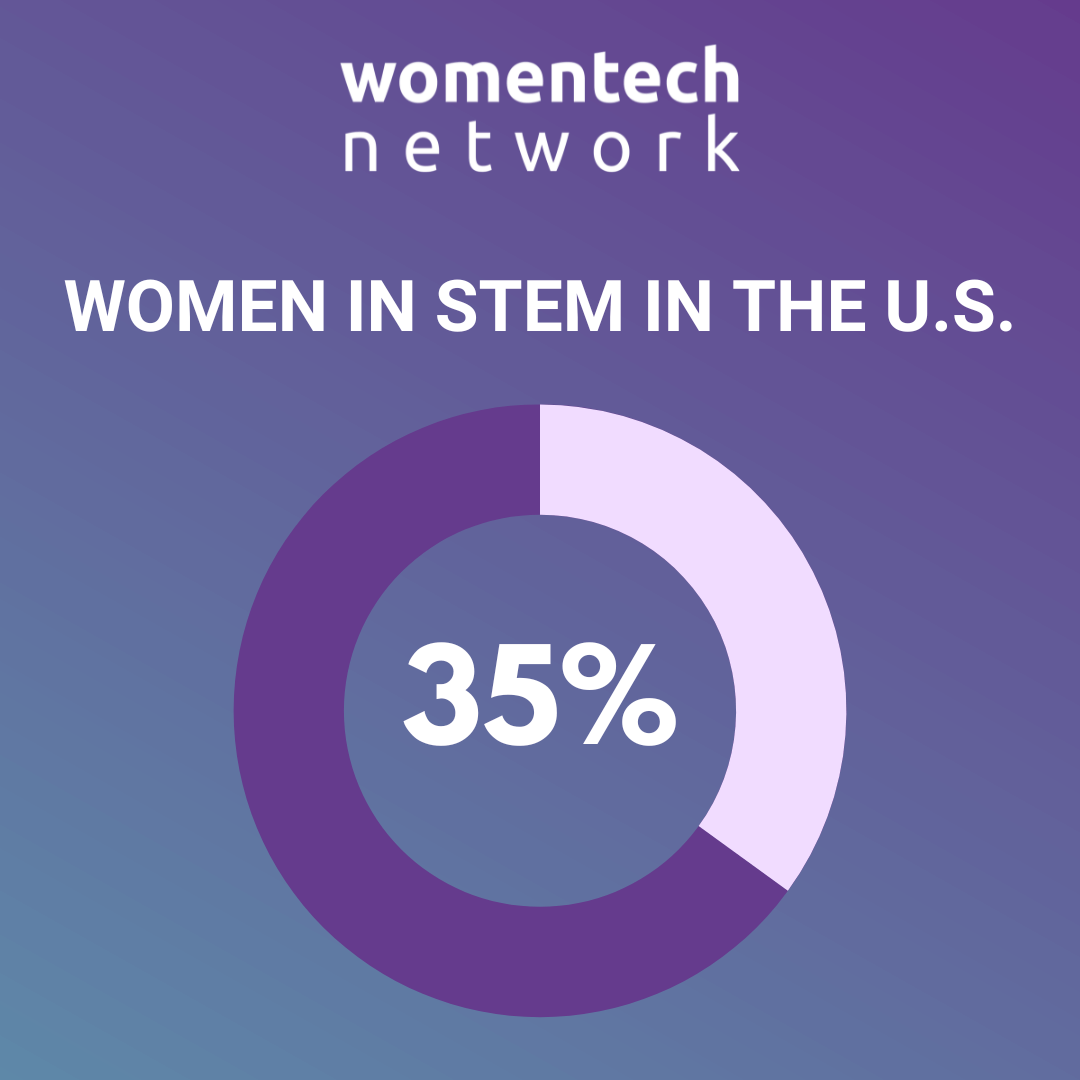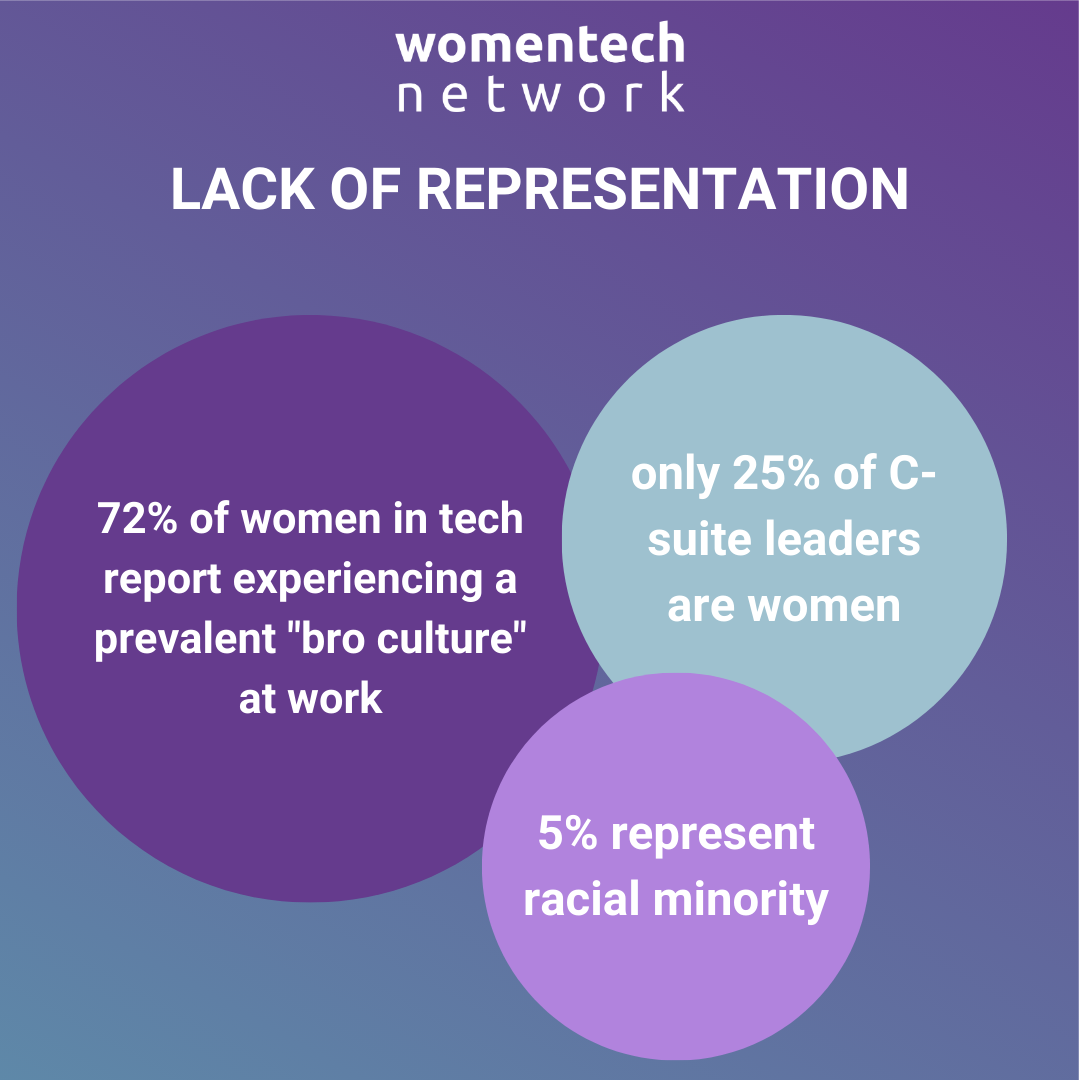Gender Gap in Tech? "Not my problem."
Every person in the world should be concerned about the gender gap present within technology. It is an issue that will have a large and lasting impact on us all, regardless of gender or background.
Shockingly, in the tech industry, less than one-fifth of employees are women despite comprising over half of America's labor force.
👉🏼 Gender Gap in Tech has a severe impact on the global economy, businesses, women and their households - thus creating a "domino effect" for everyone in our world.
After hosting hundreds of events in the tech industry, such as the Women in Tech Global Conference and the Women in Tech Global Awards, we’ve experienced firsthand the impact of women in tech uniting. Most importantly, we’ve seen extraordinary women being often deterred from entering the tech industry or leaving it prematurely due to its lack of gender diversity.
Addressing Gender Disparity in Tech: A Collective Responsibility
Technology is integral to our lives and requires diverse inputs for optimal development. Diversity, including gender diversity, enhances technology by bringing varied strengths and perspectives. Without female representation, their unique contributions remain untapped, limiting societal progress.
Zenger Folkman found that women outperform men in leadership within the tech industry, scoring 52.1% to men's 42.0%. This represents the largest gender performance gap across industries, highlighting women's exceptional leadership capabilities in technology.
According to a McKinsey report, businesses that placed in the highest fourth of gender diversity among their executive team were revealed to be 21% more likely to have higher than average profits.

In this guide, we’re going to dive into (almost) everything that goes into gender inequality in tech:
first - the reasons, then the inevitable impact and enduring effect, and – most importantly – the solutions. Upon completing this journey, you will be equipped with tangible steps that can aid in resolving this unfortunate circumstance - regardless of what role you assume.
Current State of Women in Technology - Review
The Tech Landscape for Women in 4 Numbers
The World Bank's report reveals that women are drastically underrepresented in the global workforce of technology-related fields, accounting for less than a third of total workers.
🌐 Women hold 35% of all jobs in computer and mathematical occupations in the U.S., and 15.9% of jobs in engineering and architecture occupations.
👉🏼 Despite comprising half of the US population, women occupy only 35% of all tech jobs.
See more Women in Tech Statistics.

Gaps in STEM Education: The Root Cause?
The U.S. is home to a workforce of 23% working in the STEM field, which includes people from all educational backgrounds and more men, Whites, Asians, and foreign-born individuals than are generally found in the overall population.
The gender disparity in STEM is of particular concern when examined through the lens of academic majors. Women represent only 16% among those who earned computer and information sciences Bachelor's degrees, 21% for Engineering and Engineering Technology graduates, 27% with Economics backgrounds, and 38%, Physical Sciences degree holders respectively.
👉🏼 The U.S. Bureau of Labor Statistics records an extraordinary 79% upsurge in STEM occupations over the last 30 years, with predictions that this number will rise by 11%, from 2020-2030.

Despite equal opportunities, women's enrollment in STEM, especially in computer science, remains low at 18%, with even lower rates among Black or Hispanic students at 6.3%. This limits their access to tech industry careers. There's a need to focus on young women, understanding their reluctance towards computer science and encouraging diverse career paths early. Factors potentially deterring women include lack of interest or confidence, peer pressure, negative stereotypes, underrepresentation among faculty, and societal expectations.
The Retention Problem
Even though more women are graduating with degrees in STEM subjects than ever before, female retention rates within this field remain alarmingly low. According to NCSES research, just 38% of women majoring in computer science go on to work in the sector compared to 53% of men, and only 24% of those who have an engineering degree choose a career path related to their qualifications versus 30 % for males.
Workplace Culture Issues: Flexibility, Lack of Representation, Pay Gaps, Leadership Positions
Women executives heavily value flexibility when deciding to stay with or join a business, with 49% citing it as one of the top three factors. Men leaders are slightly less likely to prioritize this aspect - about 34%. In comparison to their male counterparts, women executives are 1.5 times more inclined to switch jobs to have an environment that is focused on diversity and inclusion (DE&I).
In corporate America, progress has been slow for women, especially minorities, with only 25% in C-suite roles and 5% being racial minority women. The "broken rung" problem persists, hindering gender equality in organizations.
In tech, 72% of women face a "bro culture" promoting gender discrimination, with 63% in engineering and IT roles experiencing similar challenges, slightly less than in other tech departments.
A US study revealed a gender wage gap of 1.6%, with women earning $0.95 for every dollar their male counterparts requested when working remotely. The gap widens to $0.91 for Hispanic women and African Americans compared to white men, attributing racial injustice as a significant factor. In leadership promotions, for every 100 men promoted, only 87 women and 82 women of color are promoted, limiting their opportunities for senior roles.

Empowering Women to Rise in Tech
To make a significant shift towards gender parity in the tech industry, we must come together and encourage incremental adjustments from many different members of our society.
Here are six essential transformations that need to happen if we are hoping for an increase in female representation within technology:
Solution # 1: Encourage More Women to Take on Computer Science Degrees & Courses
The gender gap in STEM originates from societal, cultural, and gender norms influencing upbringing and education, as highlighted in the UNESCO report. To counteract this, schools can adopt strategies like introducing programming early, integrating technology into curricula, highlighting female tech role models, addressing teacher biases, creating tech clubs for girls, and inviting women in tech to speak about their experiences. Beyond education, positive reinforcement from family and community members is crucial.
Strategies include:
- Early introduction and integration of technology and computer programming in education.
- Celebrating female role models in technology.
- Creating supportive educational environments free of gender biases.
- Encouraging community and family support for girls interested in tech, including discussing technology careers and promoting technology education.
Outside the classroom, support extends to:
- Tech companies offer scholarships for girls.
- Normalizing conversations about women in tech within social circles.
- Encouraging discussions about technology careers and education with girls showing interest in tech.


Solution # 2: Ensure Equal Promotions for Women and Men
The tech industry faces a significant gender gap, with women leaving their jobs at a rate of 41% compared to men's 17%, according to the National Council for Women in Technology. Addressing this begins with tackling promotion and pay equity. Women must be evaluated based on merit rather than gender, benefiting the entire workplace ecosystem.
Despite the availability of good-paying roles, men hold 62% of managerial positions while women have 38%. Solutions include implementing best practices such as:
- Transparent Career Paths: Clearly outline career advancement opportunities and qualifications required, making them accessible to all employees.
- Personalized Career Development: Assist employees in developing tailored career plans, regularly reviewing with their supervisors.
- Mentoring Programs: Train mentors to help women in tech achieve their professional goals.
- Leadership Training: Proactively offer leadership training to high-performing employees, reaching out individually to ensure women are encouraged to participate. Hold managers accountable for gender-balanced training and promotion rates.
Solution #3: Optimize Recruitment for Female Talent Retention
A Harvard Business Review survey highlighted that 61% of women value health insurance in job searches, followed by remote work (55%), flexible hours (47%), unlimited vacation (47%), and more vacation time (40%). Men shared similar priorities, though remote work was less critical (40%).
Strategies for an empowering recruitment process include:
Inclusive Interviewing: Involve women in the interview process to address questions about flexibility and work-life balance, making the process more inclusive.
Flexibility and Visibility: Highlight your company's flexibility options and work-life balance on your website, as candidates often seek this information before applying.
Promote Female Role Models: Use your Careers page to showcase women in tech roles and share their experiences with work-life balance solutions.

Regarding job advertisements, avoid gender-biased terms like "ninja" and "dominate," which may deter female applicants. Simplify qualifications to essentials, and emphasize benefits appealing to women, such as flexibility and healthcare.
A Stanford University study found that 75% of female tech leaders were asked about marital status or family life during interviews, indicating a need for change. To improve fairness:
Include women in every interview to ensure diverse evaluations and contribute to a more inclusive culture.
Train interviewers on effective, unbiased questioning.
Offer informal interactions, like coffee breaks, for candidates to engage with the team in a relaxed setting.
Implement blind skills evaluations to minimize biases.
Solution #4: Equal Work = Equal Pay
What Causes the Pay Gap in Tech?
- Negotiation Hesitancy: Glassdoor finds women less likely to negotiate salaries, with 68% accepting initial offers vs. 52% of men.
- Wage Discrimination: Despite improvements, women earn 3% less than men overall, with Hispanic and Black women earning 91 cents and 89 cents, respectively, for every dollar earned by men.
- Raises: Women who ask for raises receive them 15% of the time, compared to 20% for men, per Harvard Business Review.
Tactics to Bridge the Pay Gap:
- Transparency in Compensation: Implementing pay grades for job roles can help eliminate discrepancies.
- Encourage Salary Negotiation: Educate and encourage everyone to negotiate salaries, reflecting ambition and dedication.
- Advocate for Equal Pay: Promote negotiation skills among women and men alike.
- Informed Salary Decisions: Women should research typical salaries for their roles using resources like Payscale and Glassdoor.
- Break the Silence on Salaries: Encourage open discussions about salaries to uncover disparities.
- Demand Pay Gap Disclosure: Urge employers to disclose pay gaps, with the federal government addressing discrepancies.
Solution #5: Develop Fair Maternity Policies for Women's Security
Maternity Leave Challenges in Tech:
- Visibility of Absence: With women constituting only 20% of the tech workforce, maternity leaves are more noticeable and can hinder career progression.
- Common Issues: Lack of Established Procedures: Often, there's no formal policy for maternity leave, contrasting sharply with the brief time off taken by new fathers.
- Loss of Projects: Women frequently lose projects or positions to less qualified male colleagues during maternity leave.
- Pressure to Return Early: 83% of women in tech feel pressured to cut their maternity leave short, often due to managerial or peer pressure.
- Negative Return Experience: One in four women finds returning to work post-maternity challenging.
Suggestions for Improvement:
- Equitable Leave Policy: Implement a gender-neutral leave policy, like Etsy’s 26-week leave for all parents.
- Parental Leave-Friendly Environment: Encourage all parents to take their full leave without career repercussions.
- Private Lactation Rooms: Provide dedicated spaces for nursing mothers.
- Mentoring for Returning Mothers: Offer support and guidance through mentoring programs.
- Phased Return: Allow new mothers to gradually resume full-time duties, easing their transition back into the workplace.
Solution # 6: Create your Circle and become a Circle Leader
- Become a Champion: Lead a WomenTech Circle
WomenTech Circles are dynamic networks championing the growth, mentorship, and connectivity of women in tech, designed to elevate leadership skills and inclusivity to close the gender gap. As a Circle Leader, you're granted a unique blend of privilege and development opportunities, backed by comprehensive resources, training, and a community support system to ensure your success and the flourishing of your Circle, making each contribution a step towards a more diverse and inclusive tech industry. Start your circle today!
- Join the Circle: A Unique Growth Opportunity
Joining a WomenTech Circle opens doors to a realm of growth and connectivity within the tech sphere. It's a nurturing environment where members can network, find mentorship, boost their skills, and gain the support of a community that shares their ambitions and challenges. Participation not only broadens your professional network but also enhances your leadership capabilities and provides you with diverse perspectives critical for climbing the tech career ladder. See all existing circles here
- Bring Your Company to the Circle
Companies also have a golden opportunity to amplify their diversity and inclusion efforts by partnering with the WomenTech Network. Encouraging female tech professionals to engage with existing Circles or to spearhead new ones within the organization is a transformative step towards achieving gender diversity. Send your partner application today
- Why It Matters: The Power of Empowerment
Empowering women in tech through WomenTech Circles is more than just building networks; it's about creating a movement toward equal representation, leadership, and success in the technology sector. It's a testament to the belief that when women are supported and empowered, they can break barriers and achieve greatness, benefiting not just themselves but the industry as a whole. Join the movement, lead, participate, and let's transform the tech world together.
About WomenTech Network:
WomenTech Network is one of the world's leading communities for women in tech with more than 9,000 Global Ambassadors representing 179 countries. 104,000 women in tech and allies have collaborated with the network to date to cultivate a diverse global network that reaches 3.7 million people. WomenTech Network strives to empower women in tech through leadership development, professional growth, and mentorship programs.
Become part of the community, and discover the benefits of WomenTech Network’s Memberships here.

